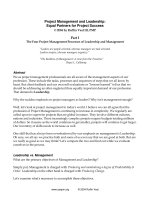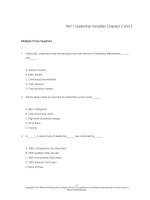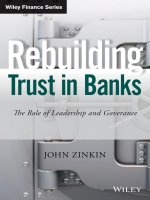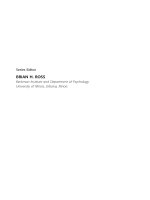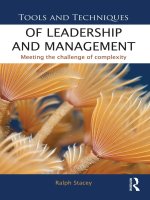Lecture Art of Leadership and Motivation - Lecture 30
Bạn đang xem bản rút gọn của tài liệu. Xem và tải ngay bản đầy đủ của tài liệu tại đây (621.93 KB, 33 trang )
Art of Leadership & Motivation
HRM – 760
Lecture 30
FACILITATOR
Prof. Dr. Mohammad Majid Mahmood
Role of Leaders in Organizational Learning &
Organizational Performance
Learning
In Organizational development (OD), learning
is a characteristic of an adaptive organization,
i.e., an organization that is able to
sense changes in signals from its environment
(both internal and external) and adapt accordingly.
3
What is Organizational Learning?
• Argyris defines organizational learning as
the process of "detection and correction of
errors." In his view, organizations learn
through individuals acting as agents for them.
4
What is Organizational Learning?
• Huber clarifies that learning need not be
conscious or intentional. Further, learning
does not always increase the learner's
effectiveness, or even potential effectiveness.
Moreover, learning need not result in
observable changes in behavior.
5
What is Organizational Learning?
• Duncan & Weiss, argue that individual
learning occurs when people give a different
response to the same stimulus, but
Organizational Learning occurs when groups
of people give the same response to different
stimuli."
6
How organizations learn?
• Argyris and Schon were the first to propose models that
facilitate organizational learning:
• Argyris and Schon (1978) distinguish between single-loop
and double-loop learning
• In single-loop learning, individuals, groups, or organizations
modify their actions according to the difference between
expected and obtained outcomes.
• In double-loop learning, the entities (individuals, groups or
organization) question the values, assumptions and policies
that led to the actions in the first place; if they are able to
view and modify those, then second-order or double-loop
learning has taken place.
7
Types of Learning
Two types of learning:
• Operant conditioning
• Social learning
8
Operant Conditioning
• Learning that takes place
when the learner recognizes
the connection between a
behavior and its
consequences.
9
Social Learning Theory
• A learning theory that
takes into account the
fact that thoughts and
feelings influence
learning.
• Necessary components
include:
– Vicarious learning
– Self-control
– Self-efficacy
10
Vicarious Learning
• Learning that occurs when one person (the
learner) learns a behavior by watching
another person (the model) perform the
behavior.
• Learners can also learn from situations in
which models get punished.
• Role models can be positive or negative.
11
Self-Control
• Self-discipline that allows a person to
learn to perform a behavior even though
there is no external pressure to do so.
12
Self-Efficacy
• A person’s belief about his or her
ability to perform a particular behavior
successfully.
• Sources of self-efficacy:
– Past performance
– Verbal persuasion
13
Learning Obstacles
Common (2004) discusses obstacles for
organizational learning in the public
sector:
resistance to change
individual interests
blame culture
14
Organizational Performance
Organizational Performance is the process
of directing and supporting employees to
work as effectively and efficiently as possible
in line with the needs of the organization
(Walters).
15
Organizational Performance
• The higher you climb the ladder in your
organization, the less chance you have
of getting feedback about your
performance.
• Those who could most use
performance feedback to enhance their
performance are often the least likely to
get it.
16
Organizational Performance myths
Myth # 1:
Executives neither need nor want performance reviews.
Myth # 2:
A formal review is beneath the dignity of an executive.
Myth # 3:
Top level executives are too busy to conduct their
appraisals.
Myth # 4:
Results are the only basis for assessing executive
performance.
17
Organizational Performance
Consider the following situations:
• The athlete searching for a coach who really
•
•
understands him.
The student waiting to see his guidance counselor at
university.
The worker who has just begun working for a new
boss.
Q:What do these situations have in common?
A:The need to manage performance effectively.
18
Learning vs. Rejection of New Ideas
19
Learning vs. Rejection of New Ideas
Gladwell believes:
Our preferences are quite unstable,
especially when we are first introduced to
something new. This is because we need
time to "learn" about the new object or idea.
We also tend to make up stories by
picking up clues when we are introduced to
something new.
20
Reframe for the Holistic
Generally heart patients, don’t follow the doctors
instructions even facing a life or death situation. Thus, how
can we expect leaders to change people?
•
•
Dr. Ornish, proved that through a holistic program
that includes going after their feelings by having them
attend a twice-weekly support group sessions led by a
psychologist. A study showed that after three years, 77% of
the patients had stuck with their lifestyle changes and
avoided the surgery.
•
Facing death for most people is much too frightening
to think about, thus patients often go into denial; where as
making daily life more enjoyable is a powerful motivator.
21
Flow Rather than Script
Give employees flexibility in their work so
that the situation is allowed to design itself,
rather than just becoming a carbon copy.
22
Velocity and Viscosity
Velocity - the speed with which knowledge moves
through an organization.
Viscosity - the richness or thickness of the
knowledge transferred.
Knowledge requires viscosity, which uses rich
sources. This is why knowledge can be so hard to
come by at times.
Organizational performance improves by focusing on
learning, reframing, flowing, and viscosity.
23
What is the Performance Gap?
Performance
Gap
Actual
performance
Desired
performance
24
WHAT DO WE MEAN BY UNDER-PERFORMANCE?
Consistently failing to deliver
key aspects of the role
25

